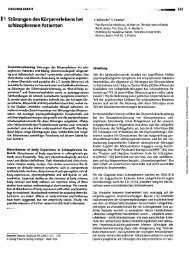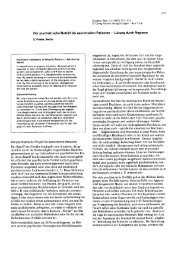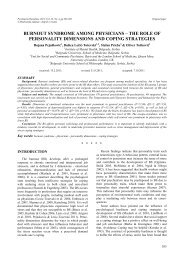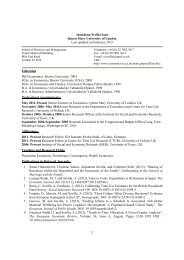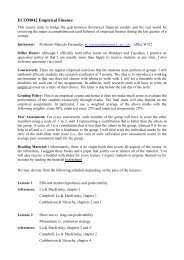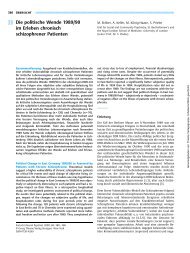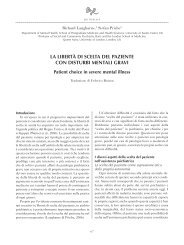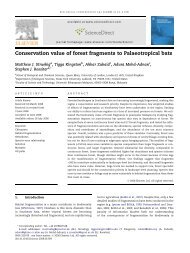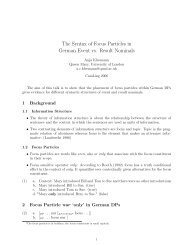Proofs - Personal Webspace for QMUL - Queen Mary, University of ...
Proofs - Personal Webspace for QMUL - Queen Mary, University of ...
Proofs - Personal Webspace for QMUL - Queen Mary, University of ...
Create successful ePaper yourself
Turn your PDF publications into a flip-book with our unique Google optimized e-Paper software.
S14 MC. Aichberger et al. / European Psychiatry 27 (2012) / supplement n°2 / S10-S16<br />
immigrant women. In additional univariate linear regression<br />
analyses unemployment was found to be associated with higher<br />
distress levels (ß=9.3, 95%CI=4.5- 14.1; p=.000), with poverty<br />
risk acting as an effect modifi er (poverty risk group: ß=14.9,<br />
95%CI=7.6- 22.3; p=.000 vs. above poverty risk group: ß=3.4,<br />
95%CI= - 3.5- 10.4; p=.328). Due to the small number <strong>of</strong> cases per<br />
cell, multivariate analysis stratifi ed by migration background and<br />
poverty risk could not be per<strong>for</strong>med. In the German group only<br />
unemployment showed a signifi cant association with increased<br />
emotional distress (ß=8.8, 95%CI=2.8- 14.8; p=.004).<br />
3.3. Composite SES indicator and emotional distress<br />
Finally, the contribution <strong>of</strong> the overall SES level (composite<br />
SES indicator) was examined in multivariate linear regression<br />
analyses. The stratifi ed analyses <strong>of</strong> the German and Turkish<br />
group revealed that the overall SES did contribute to a greater<br />
level <strong>of</strong> emotional distress in the Turkish group, but not in<br />
the German group (- 3.2, 95%CI - 5.9 – - .5; p=.020 vs. - .8, 95%CI<br />
- 2.7 – 1.2; p=.431) while controlling <strong>for</strong> age and relationship<br />
status. Relationship status modifi ed the association <strong>of</strong> SES and<br />
emotional distress in the Turkish group. To account <strong>for</strong> the<br />
effect modifi cation <strong>of</strong> relationship status, a stratifi ed analysis<br />
was per<strong>for</strong>med. In the group without a partner the association<br />
<strong>of</strong> SES and emotional distress remained signifi cant (- 5.9, 95%CI<br />
- 10.6 – - 1.3; p=.014) while controlling <strong>for</strong> age and living alone<br />
and having children, whereas <strong>for</strong> the ones in a relationship<br />
no association <strong>of</strong> SES and emotional distress (- .7, 95%CI - 4.1<br />
– 2.6; p=.675) was found anymore. However, age only remained<br />
signifi cantly associated to emotional distress in the group in a<br />
relationship (.4,95%CI .1- .6; p=.013) (Table 3).<br />
4. Discussion<br />
In this study higher levels <strong>of</strong> emotional distress were found in<br />
unemployed women independent <strong>of</strong> migration background. This<br />
fi nding demonstrates again the erosive effects <strong>of</strong> unemployment<br />
on mental well- being [15]. In this sample, the proportion living<br />
below the at- poverty- risk- threshold (49.0%) was relatively high<br />
in comparison to <strong>of</strong>fi cial fi gures, according to which 35.4% <strong>of</strong><br />
immigrants and 13.5% <strong>of</strong> non- immigrants were living below<br />
the at- poverty- risk- threshold in Berlin in 2009 [23]. The difference<br />
in socioeconomic indicators between native German<br />
and Turkish immigrant women could be explained by the social<br />
position <strong>of</strong> their families. The majority <strong>of</strong> Turkish immigrants<br />
in Germany are so- called <strong>for</strong>mer ‘Gastarbeiter’ (guest workers),<br />
who came to Germany in the late 1950s and 1960s [5]. Overall,<br />
these families have a lower socioeconomic and educational<br />
status, thus, perhaps providing fewer resources <strong>for</strong> their<br />
daughters’ educational attainment, and thereby putting them<br />
at greater risk <strong>for</strong> low socioeconomic status than their German<br />
counterparts. Levels <strong>of</strong> distress were exceptionally high in<br />
Turkish women at risk <strong>for</strong> poverty, yet no signifi cant association<br />
was found when examined in linear regression analyses. Other<br />
than unemployment none <strong>of</strong> the socioeconomic status indicators<br />
anticipated to be associated with emotional distress show<br />
a relationship with increased levels <strong>of</strong> distress independently.<br />
The association <strong>of</strong> unemployment and emotional distress is<br />
not unexpected since job loss and unemployment have long<br />
been known <strong>for</strong> being associated with ill health [38,53]. The<br />
modifying effect <strong>of</strong> poverty risk on unemployment solely in<br />
the group <strong>of</strong> Turkish women could suggest that <strong>for</strong> Turkish<br />
immigrant women the impact <strong>of</strong> unemployment on emotional<br />
distress was only exerted when associated with economic<br />
strains, whereas in the group <strong>of</strong> German women unemployment<br />
and income were unrelated. This may also be explained by the<br />
larger size <strong>of</strong> Turkish households, which mostly consist <strong>of</strong> only<br />
one or two adults supporting a number <strong>of</strong> dependents such as<br />
children or elderly relatives, which may put these households<br />
at greater risk <strong>for</strong> poverty and might be particularly distressing<br />
<strong>for</strong> unemployed women. Further analysis revealed that only in<br />
the German group was unemployment correlated with lower<br />
levels <strong>of</strong> education.<br />
Interestingly, the overall SES was only associated with<br />
emotional distress in female Turkish immigrants without a<br />
partner. It could be hypothesized that particular diffi culties<br />
may emerge when immigrant women from more collectivistic<br />
and family- oriented cultures (as e.g. Turkish immigrants) try<br />
to be economically (and socially) independent [26]. In some<br />
cultures women are the ones predominantly conveying and<br />
retaining cultural values [52]. Thus, being without a partner and<br />
being economically independent may contrast with traditional<br />
family values and parents’expectations in more traditional<br />
families [19,26]. For example, Hilmann (1999) investigated<br />
the female position <strong>of</strong> Turkish entrepreneurs and dependent<br />
workers in Berlin at the end <strong>of</strong> the 1990s and found that<br />
independent <strong>of</strong> their pr<strong>of</strong>essional position women were more<br />
likely to retain their social roles and family obligations, such<br />
<strong>Pro<strong>of</strong>s</strong><br />
Table 3<br />
Results from linear regression analyses with GHQ- 28 as the dependent variable and SES aggregated variable.<br />
Aggregated SES<br />
Turkish group<br />
Aggregated SES<br />
German group<br />
ß (95% CI) p value ß (95% CI) p value<br />
Age .2 .04- .4 0.045 - .7 - .1- .03 0.200<br />
In a relationship1 1.00 1.00<br />
Single 5.5 .1- 10.9 0.047 3.3 - .7- 7.3 0.107<br />
SES aggregate measure² - 3.2 - 5.9- - .5 0.020 - .8 - 2.7- 1.2 0.431<br />
¹ Reference category is being in a relationship or married.<br />
² Higher score is indicative <strong>for</strong> higher level <strong>of</strong> SES, ranges from 0- 4. The SES aggregate measure is constructed<br />
by ISCED level <strong>of</strong> education, poverty risk and unemployment.




